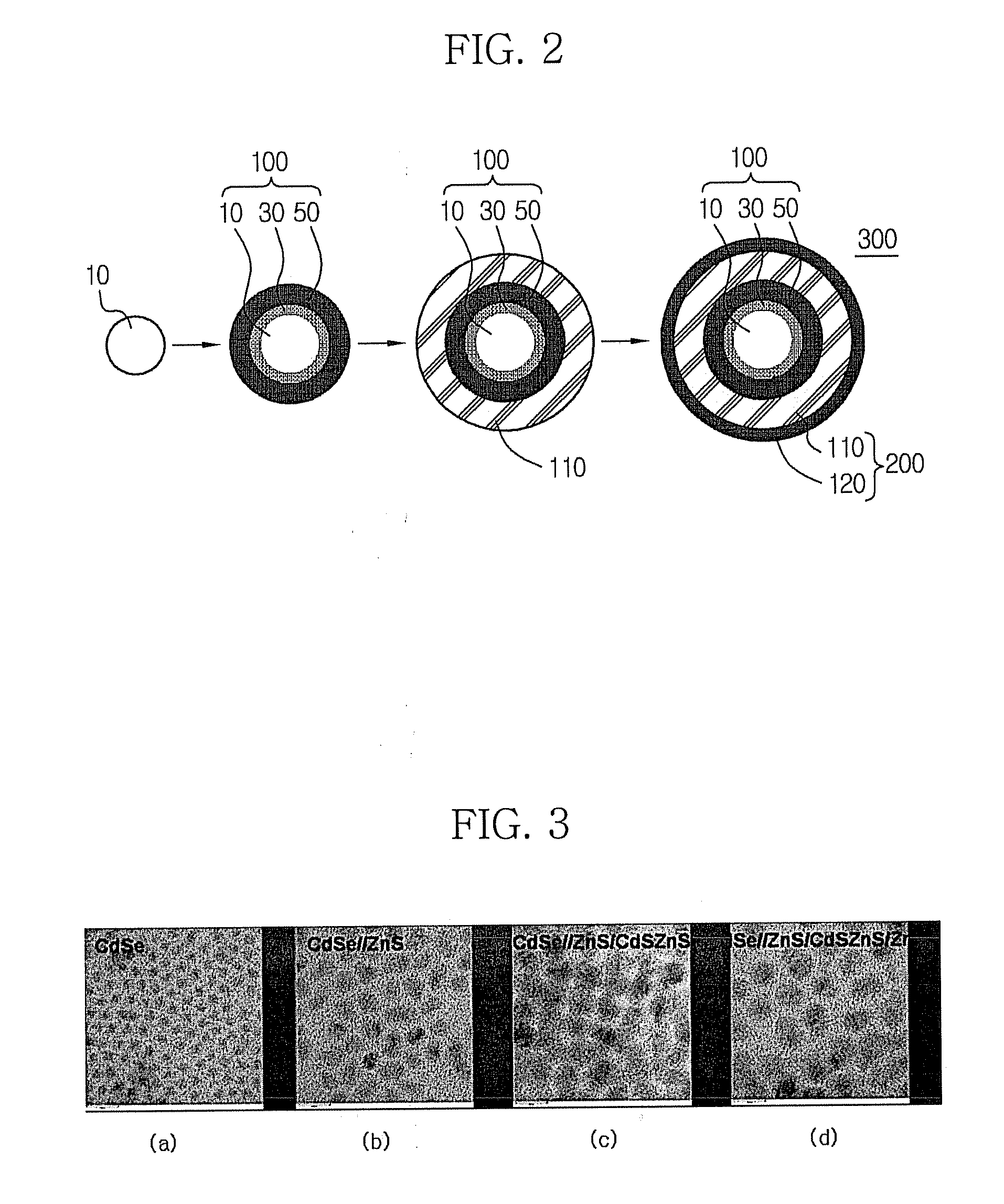Multilayer nanocrystal structure and method for producing the same
- Summary
- Abstract
- Description
- Claims
- Application Information
AI Technical Summary
Benefits of technology
Problems solved by technology
Method used
Image
Examples
example 1
[0069]Production of CdSe / / ZnS / CdSZnS Nanocrystals
[0070]16 g of trioctylamine (hereinafter, referred to as “TOA”), 0.3 g of octadecyl phosphonic acid and 0.4 mmol of cadmium oxide were simultaneously placed in a 125 ml flask equipped with a reflux condenser. The reaction temperature of the mixture was adjusted to 300° C. with stirring.
[0071]Separately, selenium (Se) powder was dissolved in trioctylphosphine (“TOP”) to obtain a Se-TOP complex solution (Se concentration: about 2 M), and 2 ml of the Se-TOP complex solution was rapidly fed to the previous reaction mixture. The reaction was continued for about 2 minutes.
[0072]After completion of the reaction, the reaction mixture was cooled to room temperature as rapidly as possible. Ethanol (10 ml) as a non-solvent was added to the reaction mixture, and then the resulting mixture was centrifuged. The obtained precipitate was separated from the supernatant, and dispersed in toluene (4 ml) to prepare a solution of a CdSe nanocrystal having...
example 2
[0080]Production of CdSe / / ZnS / CdSZnS Nanocrystals with Controlled Band Gap
[0081]8 g of TOA, 0.1 g of oleic acid, 0.1 mmol of cadmium oxide and 0.4 mmol of zinc acetate were simultaneously placed in a 125 ml flask equipped with a reflux condenser. The reaction temperature of the mixture was adjusted to 300° C. with stirring. After 2 ml of the CdSe / / ZnS nanocrystal solution prepared in Example 1 was added to the reaction mixture, 1 ml of an S-TOP complex solution (0.8 M of sulfur in TOP) was slowly added thereto. The reaction was continued for about one hour to grow a CdSZnS nanocrystal on the CdSe / / ZnS nanocrystal to produce a CdSe / / ZnS / CdSZnS nanocrystal that emits light at a wavelength of 554 nm.
[0082]After the reaction was completed, the reaction mixture was cooled to room temperature as rapidly as possible. Ethanol (10 ml) as a non-solvent was added to the reaction mixture, and the resulting mixture was centrifuged. The obtained precipitate was separated from the supernatant, and...
example 3
[0083]Production of CdSe / / ZnS / CdSZnS Nanocrystals According to Changes in Band Gap
[0084]8 g of TOA, 0.1 g of oleic acid, 0.2 mmol of cadmium oxide and 0.4 mmol of zinc acetate were simultaneously placed in a 125 ml flask equipped with a reflux condenser. The reaction temperature of the mixture was adjusted to 300° C. with stirring. After the CdSe / / ZnS nanocrystal solution prepared in Example 1 was added to the reaction mixture, 1 ml of an S-TOP complex solution (0.8 M of sulfur in TOP) was slowly added thereto. The reaction was continued for about one hour to grow a CdSZnS nanocrystal on the CdSe / / ZnS nanocrystal to produce a CdSe / / ZnS / CdSZnS nanocrystal that emits light at a wavelength of 570 nm.
[0085]After the reaction was completed, the reaction mixture was cooled to room temperature as rapidly as possible. Ethanol (10 ml) as a non-solvent was added to the reaction mixture, and the resulting mixture was centrifuged. The obtained precipitate was separated from the supernatant, and...
PUM
| Property | Measurement | Unit |
|---|---|---|
| Band gap | aaaaa | aaaaa |
Abstract
Description
Claims
Application Information
 Login to View More
Login to View More - R&D
- Intellectual Property
- Life Sciences
- Materials
- Tech Scout
- Unparalleled Data Quality
- Higher Quality Content
- 60% Fewer Hallucinations
Browse by: Latest US Patents, China's latest patents, Technical Efficacy Thesaurus, Application Domain, Technology Topic, Popular Technical Reports.
© 2025 PatSnap. All rights reserved.Legal|Privacy policy|Modern Slavery Act Transparency Statement|Sitemap|About US| Contact US: help@patsnap.com



